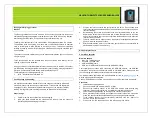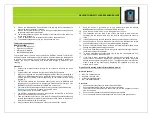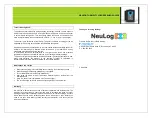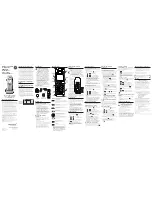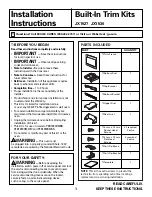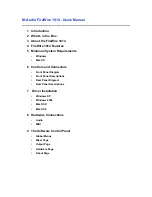
NEULOG TURBIDITY LOGGER SENSOR GUIDE
NeuLog turbidity logger sensor
NUL-231
The NeuLog turbidity sensor can be used for any science experiment which uses
samples with suspended particles in liquids such as in the fields of Chemistry, Biology,
Microbiology, Earth Science, Environmental Science, Biochemistry, etc.
Turbidity is a measurement of the concentration of suspended particles in a solution.
The particles could be anything from sand and non-dissolved nutrients to bacterial
cells. A turbid liquid is often referred to as cloudy or hazy. This sensor measures
turbidity by sending a beam of light through a cuvette and sensing the scattered light
from the beam.
The sensor comes pre-calibrated so you can start experimentation right out of the box
using this guide.
Three cuvettes with lids are included with the sensor, which load directly into the
opening on the sensor’s faceplate.
Among hundreds of possible experiments that can be done with the NUL-231 sensor
are: Monitoring of ecological systems, bacteria or yeast culturing, studying colonies of
Protozoa, environmental health testing, water quality testing, etc.
The turbidity sensor's measurement unit is:
NTU
– Nephelometric Turbidity Unit
Cuvette usage and handling:
It is important to maintain a standard for cuvette usage as their quality will directly
make an impact on the results of your experiments. If the cuvette has fingerprints,
smudges or cracks, the sensor will detect them and give off an improper turbidity
reading. Smudges left from handling can easily be wiped off with tissue paper.
Proper usage:
1.
Carefully remove the cuvettes from their packaging.
2.
Load your liquid sample into the cuvette before placing it into the sensor to
prevent spilling and damaging the sensor.
3.
Plug the cap into the cuvette and gently invert a few times. Do not shake since
this could create air bubbles which would be detected by the sensor and give an
incorrect reading.
4.
Before placing the cuvette in the sensor, hold it as far toward the top as you can
and wipe the bottom part of the cuvette with a tissue. Be careful not to touch the
bottom of the cuvette again as this could leave residues which could affect the
results of the experiment.
5.
Load the cuvette into the square hole on the sensor’s faceplate and press down
gently to slide the cuvette into place.
6.
After experimentation, empty your samples, gently rinse out the cuvettes with
distilled water and then let them air-dry.
Quick start procedure:
PC or Mac Computer
Materials needed:
NUL-231 Turbidity Sensor
Cu Cuvette Lids
USB-200 USB Module
USB to mini USB cable (included with the USB-200 module)
Your turbidity sensor needs to be connected to a USB-200 module. The USB-200
module then connects to a computer via a USB to mini-USB cable. Please note that
you cannot plug the turbidity sensor directly into the computer.
The browser based application can be downloaded for free at
well as a full application user guide.
Choose "Downloads" on the main menu and then choose "Software and Application".
Procedure:
1.
Install the NeuLog application.
2.
Connect the USB-200 module to the PC or Mac.
3.
Connect the turbidity sensor to the USB-200 module (they directly plug
together). Please note that there is no calibration required for this sensor.
4.
Open the NeuLog application by clicking on the shortcut on the screen.
5.
Once a turbidity sensor module box appears on the left side of the screen the
probe has been automatically identified and you can begin experimentation.
6.
If the turbidity sensor is not automatically identified, click the “Search for
s
ensors” icon to find the sensor.
7.
Click on the “On-line experiment” icon; this will open a graph below.

